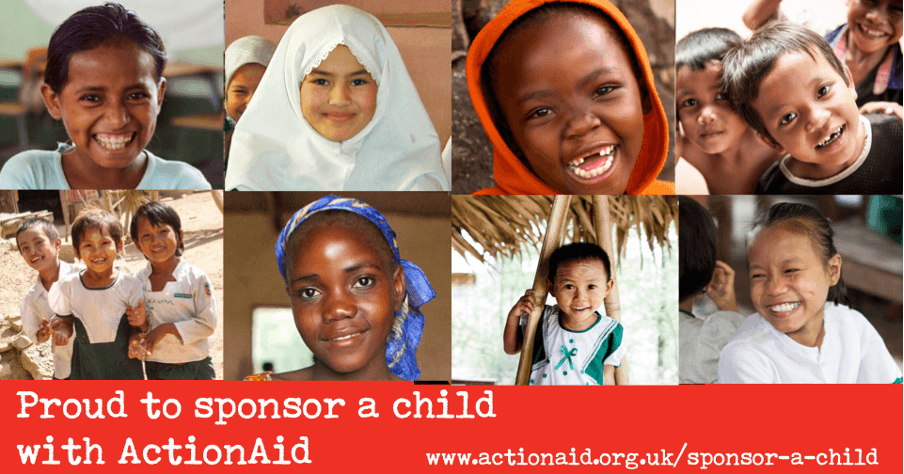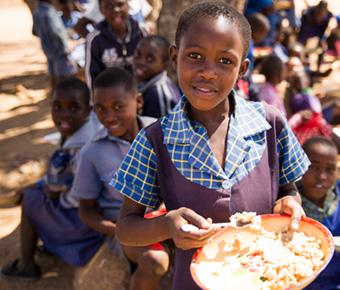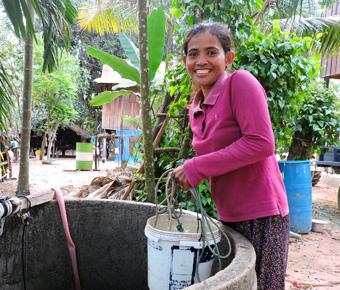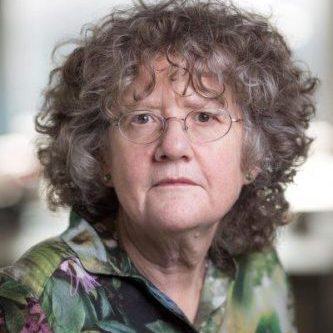Is this really the best fundraising proposition of all time? And is it good development?
The benefits, challenges and opportunities of child sponsorship as seen by Lyndall Stein, with additional material by Ken Burnett – two former directors of the international development charity ActionAid.
- Written by
- Lyndall Stein
- Added
- November 19, 2020

Child sponsorship – ActionAid’s very own problem child was born with Plan International in war-torn Spain in the late 1930s. So it’s not a child anymore but a late middle aged ‘adult.’
Unsurprisingly this child has changed immensely since it was born, the way it is structured, the way it is ‘sold’, the value to the sponsor, the value to the child – all have changed immeasurably since it was first conceived as a compelling way to link people in the North with the lives of individual children living in poverty, predominantly now the developing countries of the Global South. Decades have passed since child sponsorship was given the accolade ‘best fundraising proposition of all time’ and though a lot of the glitter has faded from that label since then, it still works, for many fabulously well.
At ActionAid, as with any long-term child sponsorship charity, there will be a myriad of documents and archived information to explain what happened when and why – and a library of the old ads and messaging, much of which might seem dated at best now, inappropriate at worst.

There are also some extraordinary human stories – children who were sponsored individually decades ago, whose lives were changed for the better; some coming back to work for ActionAid to help other children or to build the countries they live in – as teachers, doctors and agriculturalists. Village wells and entire irrigation systems built 20 years ago run by women and still working – and still run by women, villages once infested by mosquitoes and high child mortality, now free of malaria and with fully functioning maternity clinics.
In the very beginning at ActionAid, child sponsorship benefitted a particular child, helping with schoolbooks, school fees and uniform, midday meals and similar services. The charity’s aim then was to target ‘the poorest of the poor’, an ideal that proved difficult in practice. That was nearly five decades ago, and the inequity of supporting specific individuals in a class could readily be seen when the child at the next desk did not benefit.
So, child sponsorship evolved, changing to helping the whole community more broadly. Later it changed again when it was seen that you could not just help one village when the village next door had no school or benefits - so then it moved to the wider community and eventually to a local rights programme (LRP) where maximum resources are focused on a specific area, to work broadly on all local poverty rights indices.
Much of the political strength as well as the economic strength of ActionAid comes from real grounded knowledge of communities and having the long-term funding to build robust, sustainable programmes and take risks to support the struggle for rights. The long-term unrestricted funding that flows from child sponsorship (CS) developed a depth of relationships on the ground and enabled the commitment and determination of ActionAid’s programme leaders on the ground, who constantly challenged themselves to work hard, not only in the local LRP, but also on bigger issues.
Unlike other mainly US-based sponsorship charities, ActionAid was neither evangelical nor religious (though in the past many of the supporters were from faith communities). Rather it has always been determinedly secular, and the funding mechanism meant the charity had the ability to build programmes in a very organic way – no funder saying ‘you have got three years to deliver this or that’, basically, no strings attached. If the system worked, the communications and the child messages got out – the programme people had a lot of freedom to explore, to take risks, to communicate with communities, to develop real solutions.
So rather than limiting ambition, which is often how CS is pictured by those in the international development sector, it has proved to do exactly the opposite – allowing ActionAid and other agencies to develop securely funded bottom-up programmes with the full involvement of local people. The significance of its long-term nature cannot be overstated. Moreover, for more than three decades ActionAid had recruited from the Global South for the key position of country director (CD) – a very different model of leadership than most other international non-governmental organisations (INGOs). Now local leadership is increasingly considered important, but years ago a more classic expatriate model was the norm in most INGO’s – even in ActionAid, though only up until the early to mid 1980s.

Even before then ActionAid had firmly committed to improving and evolving the original child sponsorship model. Its trustees and senior management resolved to give genuine power to those on the frontline to develop the scheme to suit local circumstances and to ensure equity and fairness. Before long this led to the move away from the traditional ‘service delivery’ model to one governed by a rights-based approach.
This freedom to operate backed by strong leadership from the Global South with deep understanding of local communities and matched by the financial freedom to stretch the boundaries came together in a fertile mix from which ActionAid could develop a highly progressive agenda. So what is often perceived as a soft and ‘soppy’ product – child sponsorship – turned out to be the vital fuel for challenging the ‘neo liberal hegemony’.
The assumption that a ‘soft’ front end will end up with a soft analysis – completely misunderstands how powerful lots of unrestricted income can be in driving forward progressive programme, advocacy and policy work.
Child sponsorship presented ActionAid’s leadership in the South with an administrative burden – they had to make sure ‘Molly in Muswell Hill’ got her letter from ‘Maya in Mozambique’ and had to report in detail on some of the work they’d done based on narratives rather than much hard evidence or scrutiny. So they had to become very good at storytelling – the truth, well told. Programme leaders and CD’s could challenge, take risks, be inventive and define their own priorities. Most importantly they had lots of time to engage deeply with the communities where they worked, often in remote regions. And because ActionAid’s sponsors were so loyal, the charity was able to stay in the same areas and countries for many years and built exceptional trust within the LRPs.
But of course, ActionAid’s radical cadre of CDs were not satisfied with ‘sticking plasters’. At a crucial meeting of CDs towards the end of the 1990s they threw out the more conservative controls of the UK and a new world order was born! This was only possible because the senior management, led by charismatic CEO Salil Shetty, former director of ActionAid India and ActionAid Kenya, had persuaded the trustee board that a new order was needed. From this, internationalisation, derestriction of child sponsorship funds and investing in campaigns all followed.
This was a time of economic strength in the North and within a context of real energy and critical support for international development such as the Drop the Dept Jubilee campaign. In new supporter recruitment direct response television ads (DRTV) were doing very well, press ads ‘off the page’ were still working, and face-to- face (F2F) the ‘new kid on the donor-recruitment block’ was delivering new supporters in volume , so results were consistently successful. CEO Salil Shetty was very progressive and totally understood the value and mechanisms of child sponsorship.
During this period of success new approaches were tested and risks were taken, sustained by a bedrock of unrestricted income from the success of child sponsorship in UK, and in Italy and Greece, two investments in new countries that really worked thanks to child sponsorship. A critical element in this success was control in the early days from the UK that ensured the complex systems behind child sponsorship were effectively developed.
In addition to internationalisation, other risks and initiatives were developed during this period, including a highly successful youth/music festival programme ‘Bollocks to Poverty‘, the derestriction of child sponsorship through The Next Step programme (which encouraged sponsors to continue giving but for a different model) and the building of dynamic campaigns around food/hunger and HIV/AIDS. So this so-called ‘soft ‘fundraising product of child sponsorship allowed ActionAid the freedom to do a lot of ‘hard‘ work – it was not either, or – but both.
One of the most important factors in recruiting new donors and supporters is that the communication must be vivid and emotional. Hunting down your new supporters (forgive the aggressive analogy please), you must have a very sharp arrow – once the arrow is in, you have a long shaft behind the arrowhead which can be thought of as representing all the time and opportunities you now have to tell longer and more complex stories.
Child sponsorship works brilliantly at bringing people in – primarily by presenting a poignant image of a child who needs the donor’s direct help. The text may explain that your money will not go to an individual child, but you as an individual still feel a direct and universal emotional connection that is hard-wired into us as human beings, our desire to protect and help those who are helpless and perhaps also in need. If you want to guarantee it will not work, do what one country did a few years ago and decide to only use an image of older children – a guaranteed way to dramatically dilute your fundraising offer, because we humans just don’t have that visceral protective feeling towards an unknown older child, that we automatically have to much younger children. That’s why the 2015 picture of the little boy Alan Kurdi had such a powerful impact all around the world.
Yet for years ActionAid has tortured itself in a largely pointless way by internal criticism and arguing around the simple, successful recipe of child sponsorship. The reality is that child sponsorship brings with it lots of unrestricted income and unprecedented loyalty – no other regular giving product delivers lifetime value even close to child sponsorship, where sponsors typically stay with the organisation for seven to nine years or more. Why? Because through CS donors are connected, involved and committed – all reinforced by the communication from the LRP and the child.
Child sponsorship necessarily has a limited market – for a start it’s comparatively expensive, it may not appeal to a younger audience in the same way. Nevertheless, it will remain ActionAid’s major source of unrestricted income for the next decade at least and therefore it should be understood and respected. So, it makes sense for ActionAid to continue to invest in a product that is complex and even expensive to administer but brings with it high rewards.
Child sponsors are generally a captive audience who stay with ActionAid for so many years and are themselves a route to other audiences, their own children, at their places of work, their networks and so on. Their loyalty can also give added value, through working to get them to upgrade, to pledge legacies (another great source of unrestricted income) and to get them to add their voice and support to campaigns.
Of course, ActionAid must constantly look for new products. It pays to never be complacent and to invest in innovation. But given the strong financial position that child sponsorship has consistently delivered it pays to really value the asset it unquestionably is and the exceptional opportunities it presents.
Recruiting regular-giving donors in volume is far from easy. Every charity chases the regular unrestricted gift – few are anything like as successful as ActionAid is, particularly at comparable volumes and over a similar long time.
Recruiting large numbers of regular givers effectively calls for sustained investment, multiple recruitment channels and the kind of highly emotional messaging that, say, Save the Children can produce or perhaps Greenpeace can deliver with their intensely urgent and compelling stories.
The criticisms that so many within ActionAid have so often expressed is now amplified by new members of the ActionAid Federation, many of whom do not have resources themselves to invest in large-scale donor acquisition and are often reliant on Government funding, yet they still question child sponsorship as a product. This has created a defensiveness about CS within ActionAid, which does not create the right conditions to really analyse its strengths and weaknesses – to build on its strengths and understand and remedy its weaknesses. This negative attitude to CS risks leading the organisation into a downward spiral of failure. Child sponsorship is still ActionAid’s core product in terms of unrestricted funds and any organisation that trashes its own core product will pay the price both now and later. To avoid decline, ActionAid must understand the value of CS, how it works, its audience, its mechanisms and from there they can hope to continue to improve, to build back better and produce new dynamic products that help to create vibrant human connections – using ActionAid’s wonderful assets to connect humanity and change the world for the better.
© Lyndall Stein 2020
Lyndall Stein was director of fundraising and marketing at ActionAid International from 2000 to 2004, she returned in 2009 and worked with ActionAid UK on other occasions, most recently in 2019. Ken Burnett was UK director there from 1977 to 1979, director of fundraising and communication from 1980 to 1982 and a trustee of ActionAid from 1993 to 2009, including chair of trustees, 1998-2003. The views expressed in this article are the authors’ alone, both are writing in a private capacity.

















